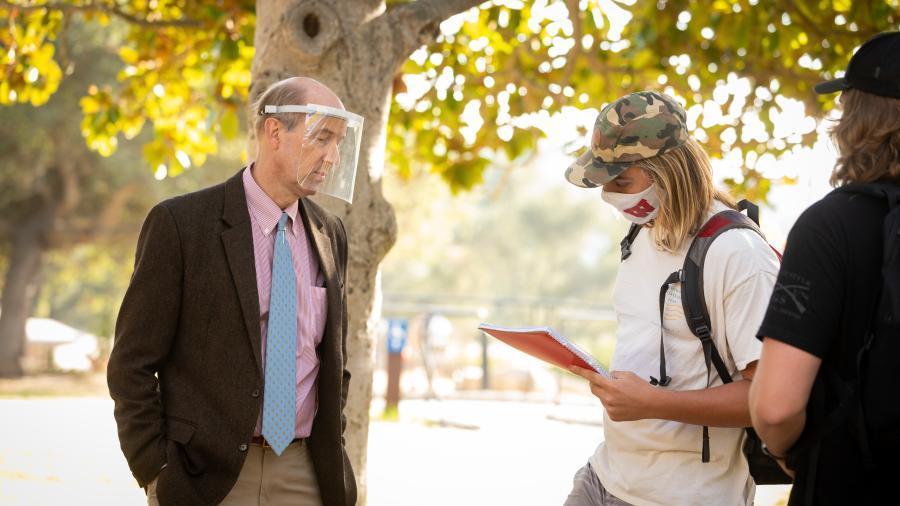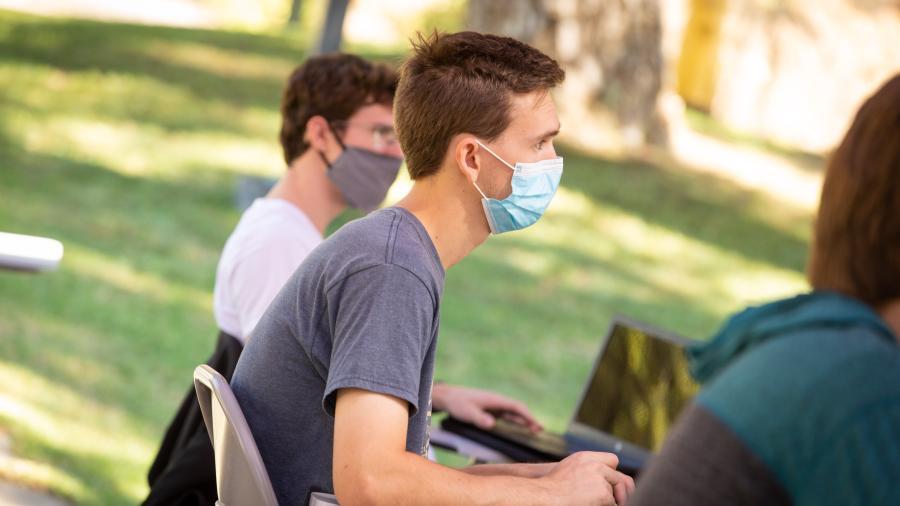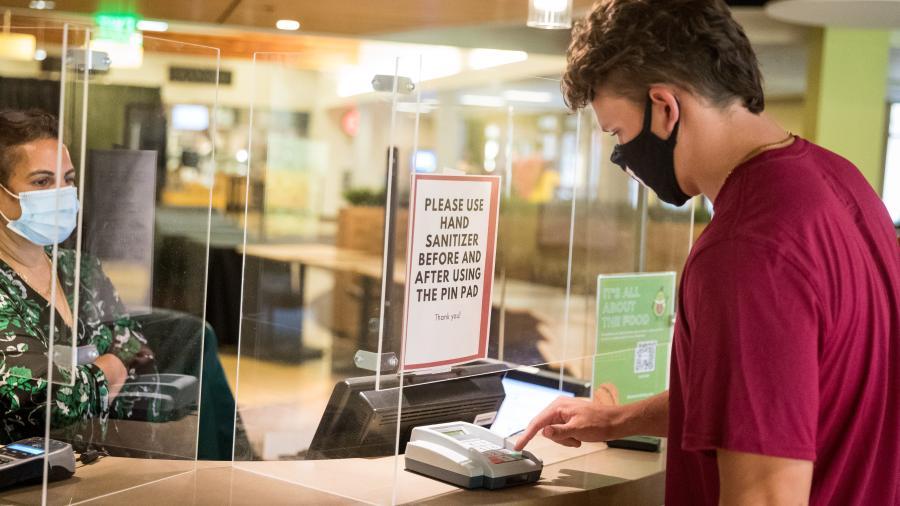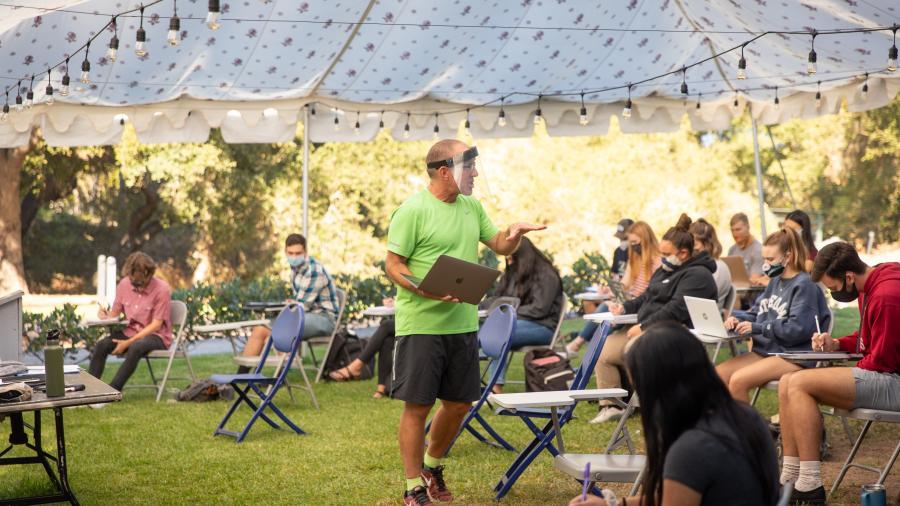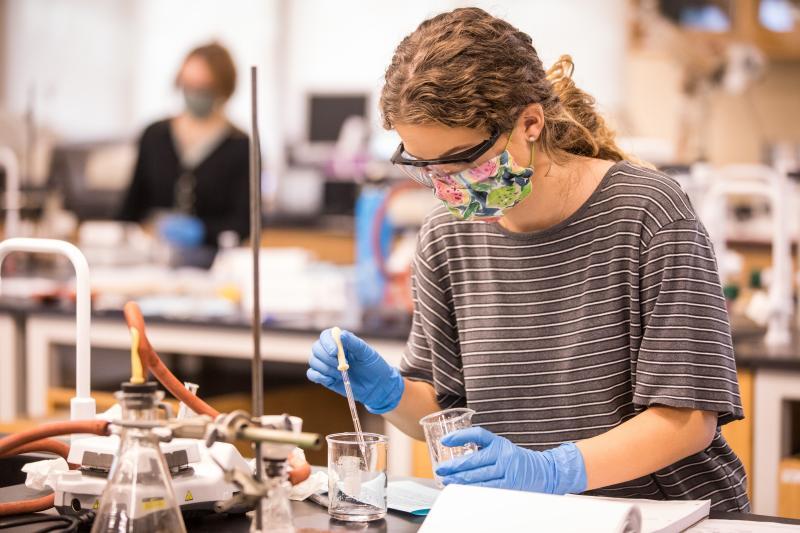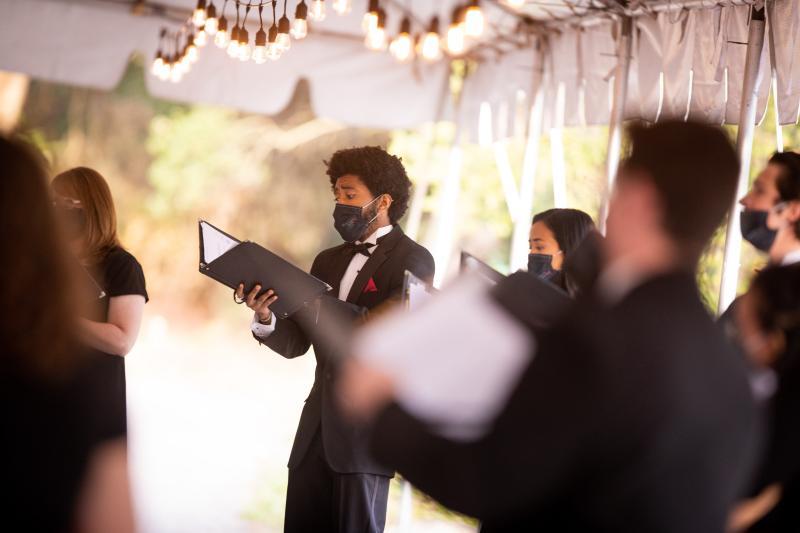Westmont Magazine Learning to Live Safely in the Midst of a Pandemic
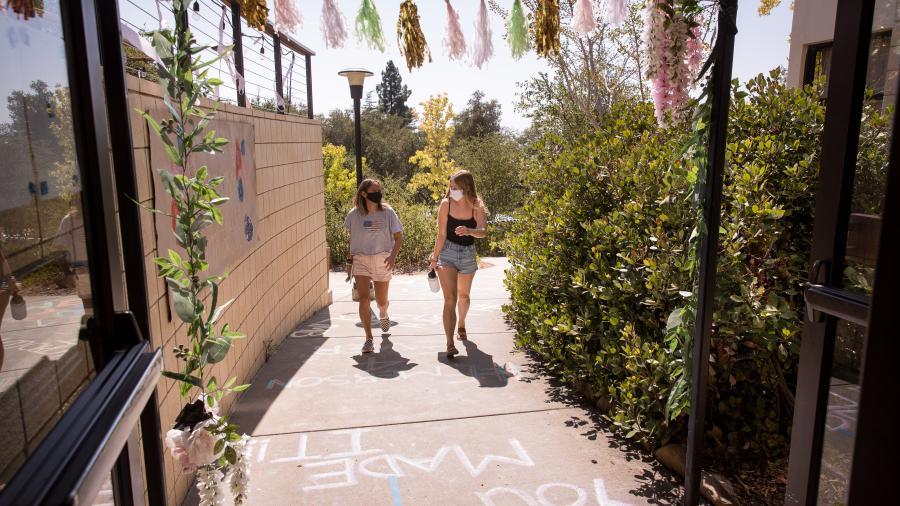
When the 2020 spring semester ended in April, Westmont officials expected to bring students back to campus and begin the fall semester on time August 28. They hoped to celebrate the postponed Commencement ceremony in October. To prepare for all the changes needed to keep students safe during a pandemic, more than 150 faculty and staff members served on 50 task forces and engaged in an intensive planning effort. Their work covered every aspect of campus life, including testing, contact tracing, isolating, cleaning, living in the residence halls, eating in the Dining Commons (DC) and a wide range of safety protocols. The groups submitted their final plans June 30, and implementation began in July. See summaries of these plans at westmont.edu/covid-19.
Throughout the summer, President Gayle D. Beebe kept in touch with students and their families with monthly conference calls, reporting on efforts to get the campus ready for a safe semester. Members of the executive team provided updates from their areas and answered numerous questions.
While Westmont canceled its scheduled summer conferences, a few activities continued. Twenty-seven students adhered to strict safety protocols to work with professors in the labs on summer research projects. Trailhead, a summer program for high school students through the Gaede Institute for the Liberal Arts, brought 23 participants to campus—12 during the first one-week session and 11 for the second. The students began considering God’s call in their life and envisioning their future. The experience with Trailhead helped the college test protocols for outdoor meetings, social distancing, masks and dining on campus.
The college’s trades team spent much of the summer cutting and installing Plexiglas throughout campus to keep people safe, separating sinks in the bathrooms, tables and serving stations in the DC, seats and tables in the library and in offices serving students. (See the related article here.)
ABC’s national “Good Morning America” program included Westmont in a story about colleges planning for the fall semester, featuring the installation of Plexiglas throughout the Dining Commons.
State officials finally issued long-awaited guidelines for reopening colleges and universities on August 7. Although declining, the number of COVID-19 cases in Santa Barbara County exceeded the threshold in the state’s metrics, and officials declined permission for students to return to Westmont.
As a result, President Beebe announced on August 11 that the college would start the fall semester remotely on August 28. But with the downward trend in the case rate and encouragement from the county, the president also declared that Westmont would bring students back to campus starting September 23, with some classes meeting in person outdoors on September 28. The incoming class of 2024 began their Westmont experience at home.
In just a few weeks, Westmont hurriedly prepared for outdoor classes. Randy Jones and the Physical Plant team identified locations on campus and tracked down tents. Austen Nelson from Conference Services helped move furniture, custodians put in extra shifts, and Registrar Michelle Hardley redid the listing of class locations once again. The college put up dozens of tents on lawns and in parking lots, wiring some for technology and lights. The tent on the tennis court provides a space where students can take exams.
Before returning to campus, all community members agreed to live and work by a Covenant during COVID, which requires participation in safety protocols, testing, contact-tracing, daily symptom checks and reports using a special app, and sanitizing personal and shared spaces. The covenant encourages thoughtfulness, consideration and grace during a difficult time.
Professors and staff members worked diligently up to September 23, when students began arriving at staggered times to limit the number of people on campus and promote social distancing. Each student could bring only two people for an hour to help them unload.
As soon as possible, students got tested for COVID-19. In all, more than 1,400 students, faculty and staff endured the nasal swab. Remarkably, only five received positive results. They and their roommates and the people they’d interacted with went into immediate isolation. In August, three students living off campus had tested positive, making only eight positive test results from August 1 through the end of November. For much of the semester, there have been no active COVID-19 cases on campus.
“This is great,” says Jason Tavarez, director of institutional resilience. “Our positivity rate is less than half a percent, which is well below any of the thresholds we set. We’re one of the few schools in California able to offer outdoor classes in person because students followed the rules and protocols. I’m impressed that everyone approached this endeavor with such seriousness.”
“We know this fall looks very different, but we’re committed to making a Westmont education safe and enjoyable this fall semester,” President Beebe says. “We’re the right size to shift and pivot as we need to, observing and respecting restrictions and regulations and taking advantage of opportunities such as outdoor learning under large tents. The safety of our Westmont community remains our highest priority.”
More than 90 percent of students chose to return to campus rather than continue learning remotely in their homes. “The response to in-person learning and living in community demonstrates how much students crave being together,” says Irene Neller, vice president for enrollment. “Even with our strict safety guidelines, they’ve chosen to live in residence halls and learn under tents.”
Students took the need for safety to heart, responding positively to the requirements to wear masks, practice physical distancing and limit gatherings to just a handful of friends, embracing #maskupwarriors and #protectthemont.
At first, classes could only meet in person outdoors. Students and professors all wore masks and sat at least six feet apart. Then, as expected, Santa Barbara County dropped out of the most restrictive COVID-19 tier, from purple to red, and Westmont moved some classes indoors starting October 13. Regulations limit each indoor class to 25 percent of the room’s capacity. Most students who’ve returned to campus have attended at least one class in person, and some take all their classes face-to-face.
“This is great news because it means we can provide indoor classroom experiences and include more people in art studios and science labs, which allows greater access to experiments,” Taverez says.
“I’ve seen my professors exhibit creativity in the ways they’re using breakout rooms in Zoom and allowing classes to meet in person outdoors while having a Zoom option for students quarantining or still living at home,” says Chloe Howard, junior anthropology major. “This is a super strange and hard time we’re living in as a nation right now, but I couldn’t be more proud to be a Warrior. I know we’re lucky we were able to return to campus and live with our Westmont community again.”
On October 13, Voskuyl Library reopened with a limited schedule (9 a.m.-5 p.m. Monday through Friday and 1-5 p.m. on weekends), but services such as Research Help, Library Tutoring, Writers’ Corner and askalibrarian@westmont.edu continued to offer assistance remotely. Previously, students could request books and pick them up at the library door.
Meanwhile, campus officials had to make some difficult decisions. They canceled all public events and student gatherings for the fall and announced that the college’s popular overseas programs would not resume until the fall of 2022.
Students attend chapel online and participate in their various clubs and activities through Zoom. All the college’s lectures and arts activities have occurred virtually, opening the events to new audiences who live outside of the Santa Barbara area. The Westmont Ridley-Tree Museum of Art has presented exhibitions online and created numerous art activities people can enjoy at home. The music department has performed a new concert every Friday evening. Westmont’s theater program offered an innovative virtual production, “small enchantments,” also available online. Check the Westmont website for links to all these events and more.
The Westmont campus remains closed to everyone except faculty, staff and students to protect the community throughout the semester. Security guards stationed at both entrances monitor the people coming to the college. Family members may visit their students if they call in advance. Vendors and anyone seeking to visit Westmont on business need an invitation and an appointment. The college welcomes all prospective students who sign up with the Admissions Office to visit and are asked to wear masks during their vist and agree to adhere to the college’s safety protocols.
The custodial team has worked tirelessly to sanitize every bathroom on campus daily, using advanced technology to disinfect areas with products that provide up to eight hours of continued sanitization. Cleaning protocols requires students and professors to use disinfectant wipes to clean their classrooms—outdoor and indoor—at the end of each class. This includes wiping down all the desks, chairs, whiteboards and lecterns being used, a sign of respect and care for the next class.
What happens when someone gets sick or has spent time with a person who develops COVID-19? Students who become ill list people who’ve been within six feet of them for 15 minutes or more. Those with symptoms and/or positive tests go into isolation by moving to private rooms with their own bathroom, shower and refrigerator and get their meals delivered. They remain until they clear the appropriate protocols under the direction of Dr. David Hernandez in the Westmont Student Health Center. Students with no symptoms but exposure follow a less stringent quarantine in their own room. They also get meals and supplies delivered.
“During our contact-tracing efforts, we’ve had incredible responses from students,” Tavarez says. “Contact tracing is the key way to stop the spread of virus on campus, and students have responded promptly to our calls and emails, letting us know who other potential contacts might be.”
Students who’ve been quarantined helped student life staff create hospitality teams to provide art supplies, assistance with outdoor movie parties, materials from counseling and psychological services on emotional wellbeing, and coffee from Ritchie’s Place on lower campus.
Many students have enjoyed learning and eating under the large tents amidst the outdoor beauty and fresh fall breezes. “We’re so fortunate to be in Montecito,” Neller says. “Some of my colleagues from around the country have shared that they’re shifting back to remote learning to complete the fall semester as the weather becomes too cold or unpredictable to remain outdoors.”
Feeding students proved to be one of the more challenging tasks with no seating available in the DC. Students can grab food to go or wait in a socially distanced line to pick up their meals from one of the serving stations inside. At first, the line moved slowly, but the DC staff made adjustments to speed things up. Students eat under a tent or take food back to their rooms. But they can’t go back for seconds, so they have to load up on their one trip through the DC. The staff has also worked to provide enough sustenance for all students, including athletes.
Innovative programs included Worship Under the Stars October 29, a time of masked, socially distanced prayer and singing, led acoustically. Students, who dressed warmly, received chapel credit.
Armed with the latest studies and experiments on aerosol dispersion for musicians and singers, Michael Shasberger, Adams professor of music and worship, crafted innovative plans to allow the choir and orchestra to safely perform during the pandemic. No more than 12 singers practice at a time, spaced 14 feet apart outside, wearing masks and singing for no more than 40 minutes.
The orchestra began the semester rehearsing as four smaller ensembles, two for strings and each for brass and wind instruments which were featured on their first video concert performance. Customized face masks, instrument bell covers, plexiglass shields in critical locations, and much wider than normal spacing for all performers established a safe environment for the music making. As the musicians adjusted to the new protocols and spacing the ensemble was able to assemble fully outdoors for rehearsal and their first concert video and briefly indoors for the annual Christmas Festival recording. Choirs met in chamber groups rather than full ensembles to begin the semester, rehearsing outdoors and in widely distanced formations.
The Music Department produced 15 video concert performers over the course of the fall semester, all of which are available on the Music Department website at westmont.edu/music/concerts. The programs began with faculty and alumni offerings and then moved to student work once musicians were back on campus and could rehearse together in October. The programs range from solo recitals to large ensemble offerings indoors and outdoors in beautiful campus settings. Full pdf’s of all the programs along with videos will be available for viewing throughout the academic year. The fall series reached its climax with the release on December 4th of the 16th annual Christmas Festival entitled “Ris’n With Healing In His Wings.” The department plans to continue the series in the spring semester as weather and in-person instruction allows.
For their first event of the year, the Westmont Activities Council held Organizations Stations on Zoom, working “to create community even in the virtual setting.” Leaders of various student organizations hosted their own Zoom meetings and interested students could attend one or more. The Westmont College Student Association (WCSA) added Take a Professor to Tea to their popular Take a Professor to Lunch program to “continue building relationships between professors and students as well as spaces for conversations important to our community.”
Two additional rounds of testing, each including about a third of the community, failed to yield a single positive result. All students, faculty and staff got tested once again after Thanksgiving, and only six people were positive. They went into isolation as did those they’d been in contact with. Westmont’s positivity rate continued to be below 1 percent. On November 16, Santa Barbara County moved back into the purple tier, the most restrictive one, because of a rising number of COVID-19 cases. Classes moved back outdoors, except for labs and studio classes, which limited attendance to 25 percent of capacity.
“During this unprecedented time in global history, Westmont community members have continually risen to the occasion, with students excelling in virtual classes, professors innovating how they teach, and staff finding novel ways to serve and reach our entire community,” says President Beebe. “I’m so proud of our students and their willingness to keep their campus and community safe. These extremely low COVID-19 cases demonstrate the high desire to learn and live together and that’s the Westmont way.”
